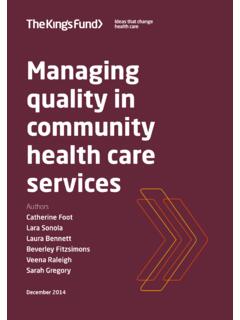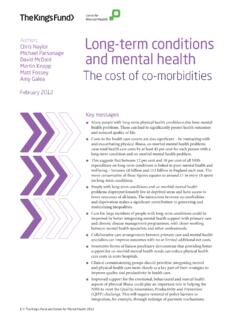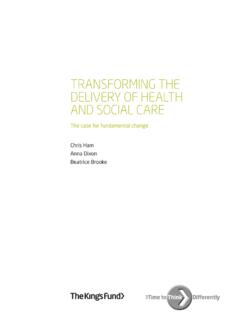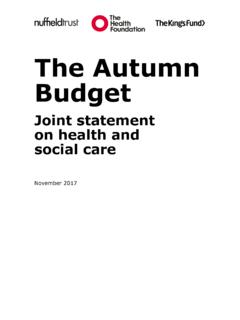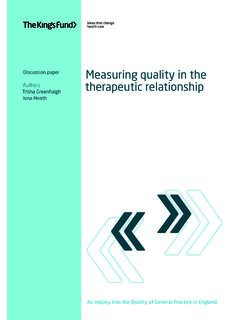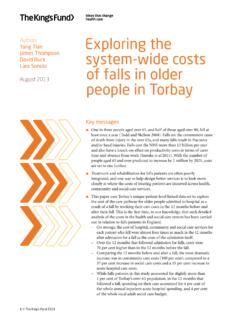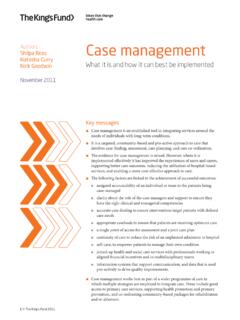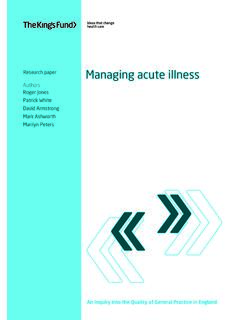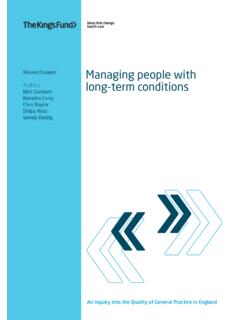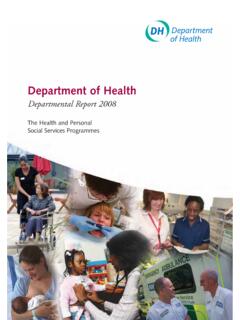Transcription of Polypharmacy and medicines optimisation - King's Fund
1 AuthorsMartin DuerdenTony AveryRupert PaynePolypharmacy and medicines optimisationMaking it safe and soundPublished byThe King s Fund11 13 Cavendish SquareLondon W1G 0 ANTel: 020 7307 2591 Fax: 020 7307 The King s Fund 2013 First published 2013 by The King s FundCharity registration number: 1126980 All rights reserved, including the right of reproduction in whole or in part in any formISBN: 978 1 909029 18 7A catalogue record for this publication is available from the British LibraryAvailable from:The King s Fund11 13 Cavendish SquareLondon W1G 0 ANTel: 020 7307 2591 Fax: 020 7307 2801 Email: by Anna BrownTypeset by Peter Powell Origination & Print LimitedPrinted in the UK by The King s Fund The King s Fund is an independent charity working to improve health and health care in England.
2 We help to shape policy and practice through research and analysis; develop individuals, teams and organisations; promote understanding of the health and social care system; and bring people together to learn, share knowledge and debate. Our vision is that the best possible care is available to all. The King s Fund 2013iiiList of tables and figures ivAbout the authors and acknowledgements vForeword viiKey points ixIntroduction
3 1 What is Polypharmacy ? 1 Why Polypharmacy is an important challenge 21 Measuring Polypharmacy 5 Defining Polypharmacy according to numbers of medicines 5 Tools to assess appropriateness of prescribing in Polypharmacy 5 Proposed pragmatic approach for identifying higher-risk Polypharmacy 72 The epidemiology of Polypharmacy 9 Polypharmacy in primary care 9 Polypharmacy in hospitals 10
4 Medication use in care homes 11 Polypharmacy in other countries 11 Multi-morbidity and ageing as driving factors 133 medicines optimisation and Polypharmacy 17 Evidence for improving medicines management in Polypharmacy 17 Reducing medication errors 19 Polypharmacy and use of monitored dose systems 19 Medication review and repeat prescribing 20 Polypharmacy at discharge and medicines reconciliation 21 Suggestions for improving care in the context of multi-morbidity 22 medicines management in care homes 23 Polypharmacy and stopping medicines 24 Medication waste, medicines management and Polypharmacy 254 Evidence-based Polypharmacy 275 Prescribing and Polypharmacy in older people 29 Are drugs for older people effective?
5 29 Medication reviews, Polypharmacy and older people 306 Polypharmacy and the patient experience 327 Summary 338 Case examples and practical tips 349 Resources 39 References
6 49 Contentsiv The King s Fund 2013 List of tables and figuresTablesTable 1 Prescribing indicators used to identify problematic or inappropriate Polypharmacy 6 Table 2 Year-on-year change for drugs used to treat diabetes, England, 2005/6 to 2011/12 14 Table 3 Reducing relative and absolute risk through Polypharmacy 27 Table 4 The Hypertension in the Very Elderly Trial (HYVET)
7 30 FiguresFigure 1 Prescription items dispensed per head of population in UK countries, 2011/12 2 Figure 2 Trends in prescription items dispensed, England, 2001 to 2011 3 Figure 3 Multiple drug use, Scotland, 1995 and 2010 3 Figure 4 Polypharmacy , Sweden, 2005 to 2008 12 Figure 5 Number of chronic disorders by age group 14 Figure 6 Estimated and projected age structure, UK population, mid-2010 and mid-2035 15 Figure 7 Estimated and projected population aged 85 and over, United Kingdom, 2010 and 2035 16 Figure 8 Selected co-morbidities in people with coronary heart disease, diabetes.
8 COPD or cancer in the most affluent and most deprived areas of Scotland 16v The King s Fund 2013 About the authors and acknowledgementsMartin Duerden has worked as a part-time GP in Conwy, North Wales since1999. In 2003 he became Medical Director at Conwy Local Health Board, reorganised to Betsi Cadwaladr University Health Board (BCUHB) in 2009. He now works as Deputy Medical Director for BCUHB, which covers all hospital and primary care services for North Wales. He is also a clinical senior lecturer at Bangor qualified at Newcastle University and was a full-time GP in the north-east of England for eight years until 1994.
9 He worked for several years as medical adviser to East Norfolk Health Authority and then trained in public health medicine in Cambridge. For three years he worked as Medical Director for the National Prescribing Centre for England, based in Liverpool. Following this, from 2001, he worked on various projects: as a medicines management consultant in University College London Hospitals Trust; on the PRODIGY project on decision support for general practice; and at Keele University. He is on the editorial board of Prescriber and on the paediatric formulary committee for the BNF for Children.
10 He sits on a NICE Technology Appraisal Committee and NICE Clinical Guideline Group. He organised the Diploma in Therapeutics at Cardiff University between 2005 and 2010. He was co-author of The King s Fund report on the quality of GP prescribing. He is a clinical adviser to the Royal College of General Practitioners on prescribing and on evidence-based Avery is Professor of Primary Health Care, School of medicine , University of Nottingham, and a part-time GP in Chilwell, Nottingham. Tony qualified in medicine from the University of Sheffield and has been a clinical academic at the University of Nottingham since has a longstanding interest in prescribing and patient safety and has led a number of large studies investigating the prevalence and causes of prescribing errors, and identifying effective methods for improving patient is Consultant Editor of the journal Prescriber and a member of the Primary Care Safety Board of NHS England.
